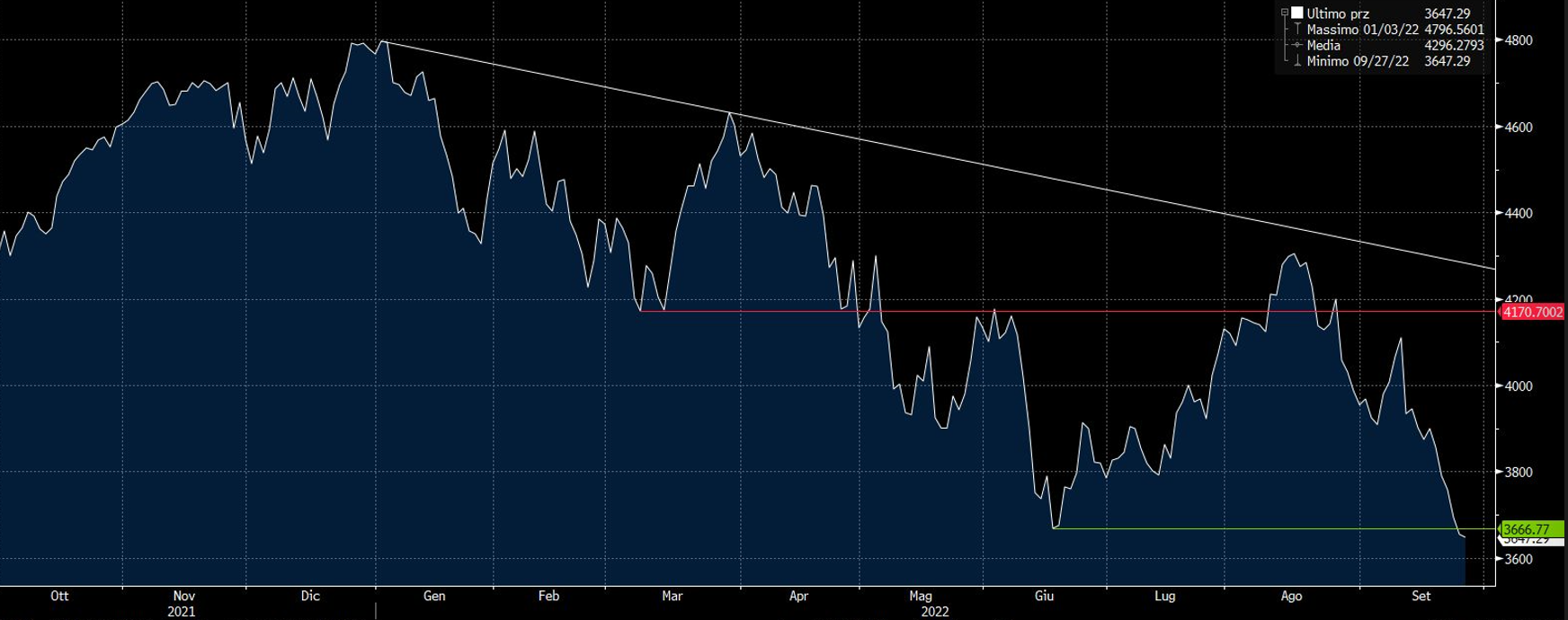We have almost reached the end of a year that will remain in history for various reasons, from the war in Ukraine, to inflation at the highest levels for decades, but also due to the negative performance of the markets, with no asset class that has managed to escape sales. The global bond market has registered a nominal -20% since the start of the year and in America real rates have broken 1% for the first time in the last decade, with short and long rate curves being the most reversed of the last twenty years. It is certainly no better for equity markets, which after the technical rebound at the turn of July and August, have returned to showing strong weakness both in America and in Europe. Since the beginning of the yearthe S&P 500 index it is down by 23.5%, while in the Old Continent the EuroStoxx 600 index is down by almost 22%, thus marking the entry into a Bear Market for the first time in the last eight years.
The S&P 500 index
Recession getting closer?
Volatility reigns in the markets and by now it is clear that investor sentiment is disheartened, with more and more operators expecting a recession and in the meantime the share of liquidity in funds is growing, which is the highest in decades. The strong inflationary push of the last few months continues to erode the purchasing power of investors, but if in America there are several components of the CPI they are slowing down the race; in Europe the situation remains dramatic due to high energy costs and it is clear that the energy independence process (initiated after the Russian invasion of Ukraine) will entail huge costs. In this sense, as Kairos analysts recall, low-cost energy is the engine of the economy, it was during the English industrial revolution with coal and it will be in the future thanks to the development of renewable sources.
The other element of concern that is catalyzing the attention of investors concerns the moves of the various Central Banks which, with the aim of countering high inflation, are raising rates at a record pace, thus marking the end of the credit era. low cost, but this could lead to a sharp decline in the economy.
According to Alessandro Fugnoli, Strategist of Kairos, we are facing a planned recession, but despite all the turbulence there is a positive aspect, namely that we are entering recession in a “controlled” context and not in chaos as happened during the 2008 crisis. to underline is the surprising resilience of consumption, as well as the strength of the labor market in the United States. As Fugnoli points out, the context for the markets “will change positively only when companies have accepted the idea of restructuring, streamlining and recovering productivity and when they do, (with a good chance towards the middle of next year), the Fed will be able to start to loosen the grip on rates; and this will be the time when financial assets stabilize and prepare for recovery.
Many challenges for Italy
For our country too, expectations on the stock market for the fourth quarter are conditioned by the global macroeconomic and geopolitical situation. Italy has just faced the national elections, the result of which has highlighted a substantial majority of the center-right both in the Senate and in the Chamber and this portends a government with Giorgia Meloni as Prime Minister.
This result was widely expected by the market, which does not like uncertainty and from this point of view Meloni reassured investors several times during the election campaign, claiming to be opposed to large budget variances, to reformulating the PNRR, to exit from Europe and lift sanctions on Russia; we will see if these indications are respected.
However, the market has worsened in recent sessions on growing recessive fears, and in these last sessions, sectors such as oil, industrials and banks do worse, with correlated overperformance of oil and financials and underperformance of technology and quality.
Here, as in America, until we see a peak in in fl active data (hence a peak in rate hikes), the market is unlikely to take a definitive direction.
Indice Ftse MIB

In Piazza Affari the segments that are suffering the most are the mid and small caps and from this point of view theStar index is losing more than 30% since the beginning of the year. As the analysts of Kairos observe, “on the Star segment we may have reached a minimum, moreover, the earnings estimates have already been largely cut this year and partly also on the next year and therefore precisely in this segment that with great caution and selectivity, investment opportunities can be identified for the medium term “.
In conclusion, the last quarter of the year promises to be as challenging as the first three, but we are perhaps a little more aware of what awaits us with the valuations of stocks already at relative lows and with the positioning of very bearish market operators. However, it must be remembered that when the current “sell the rally” mentality passes, the “buy the deep” will return to dominate and then we will see that the market returns to perform.
